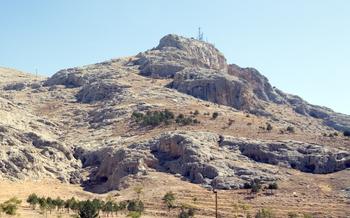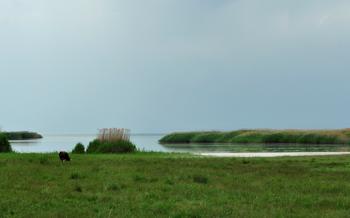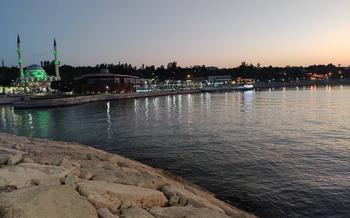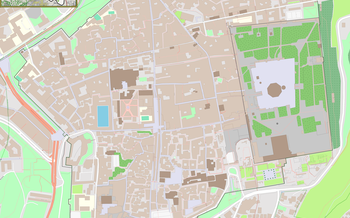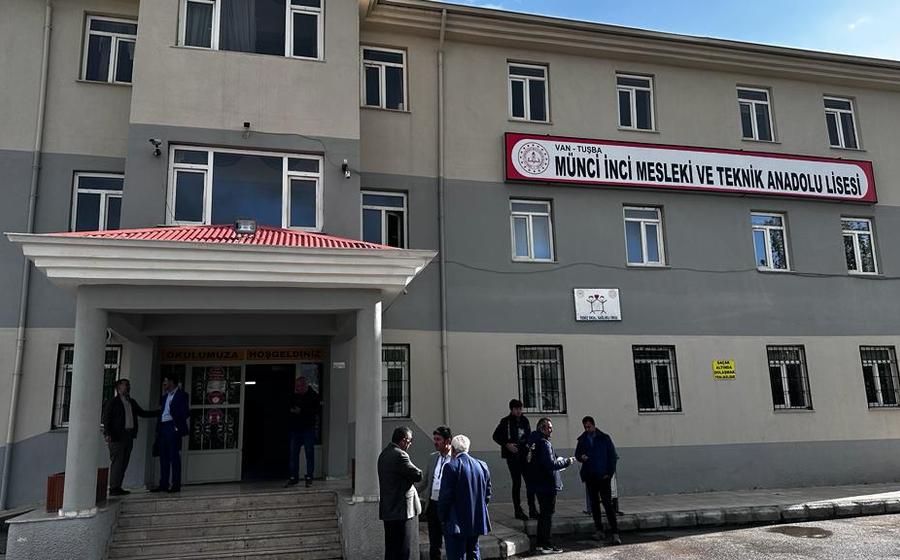
Altınsaç Tomb
- Historical Significance
- Architectural Marvel
- Location and Access
- Interior Design
- Myths, Legends, and Folklore
- Excavation and Discoveries
- Historical Context
- Cultural Significance
- Preservation and Conservation
- Visitor Experience
- Nearby Attractions
- Local Cuisine
- Photography Tips
- Ethical Considerations
- Insider Tip
Historical Significance
The Altınsaç Tomb stands as a testament to the rich cultural and archaeological heritage of Turkey. Built in the 4th century BC, it is one of the oldest and most significant tombs in the region. Its historical significance lies in its association with the ancient kingdom of Urartu, a powerful civilization that ruled over parts of eastern Anatolia. The tomb is believed to have been built for a high-ranking Urartian official, possibly a governor or a military commander, and its elaborate architecture and impressive artifacts offer a glimpse into the grandeur and opulence of the Urartian civilization.
The Altınsaç Tomb is unique among Urartian tombs due to its exceptional preservation. While many other tombs have been damaged or destroyed over time, the Altınsaç Tomb remains remarkably intact, with its intricate carvings, wall paintings, and inscriptions still visible. This makes it an invaluable source of information for archaeologists and historians, providing insights into Urartian art, architecture, and burial practices.
Architectural Marvel
The Altınsaç Tomb stands as a testament to the remarkable architectural prowess of its ancient builders. Constructed using locally sourced stones, the tomb's exterior boasts intricate carvings and decorative elements that showcase the region's rich artistic traditions. The entrance, adorned with elaborate moldings and a striking triangular pediment, invites visitors into a world of historical wonder. Inside, the tomb's spacious chamber reveals a series of vaulted ceilings, supported by graceful columns and arches. The walls are adorned with intricate frescoes, depicting scenes from mythology and everyday life, offering a glimpse into the beliefs and customs of the ancient people who built this magnificent structure. The Altınsaç Tomb's architectural design not only serves a functional purpose but also reflects the cultural and artistic sensibilities of its time, making it a true masterpiece of ancient craftsmanship.
Location and Access
The Altınsaç Tomb is located in the Erciş district of Van, Turkey, approximately 120 kilometers from the city center. To reach the tomb, you can take a bus or taxi from Van to Erciş, and then transfer to a local minibus or taxi to the village of Altınsaç. The tomb is situated on a hilltop overlooking the village, and visitors can easily find it by asking for directions from the locals. The nearest airport is Van Ferit Melen Airport (VAN), which offers domestic flights to major cities in Turkey. From the airport, you can take a taxi or rent a car to drive to Erciş and then to the Altınsaç Tomb.
Interior Design
The interior of the Altınsaç Tomb is a testament to the artistry and craftsmanship of its creators. The tomb features a single, large chamber, adorned with intricate wall paintings, motifs, and inscriptions that provide valuable insights into the beliefs and culture of the people who built it. The walls are covered in vibrant frescoes depicting scenes from mythology, hunting, and everyday life, offering a glimpse into the world of the ancient people who once occupied this space.
The ceiling of the tomb is adorned with stunning geometric patterns and celestial motifs, creating a sense of awe and wonder. The use of vibrant colors, such as reds, blues, and greens, further enhances the visual impact of the interior. Inscriptions in ancient languages, possibly offering prayers or dedications, are scattered throughout the tomb, adding to its historical and cultural significance.
The tomb also contains several niches and alcoves, which were likely used to store offerings or funerary objects. These niches are often decorated with intricate carvings and reliefs, showcasing the attention to detail and artistry that went into the creation of this magnificent tomb.
Myths, Legends, and Folklore
The Altınsaç Tomb is shrouded in a veil of mystery and intrigue, giving rise to a captivating array of local legends, myths, and folklore. One enduring tale speaks of a beautiful princess named Altınsaç, whose golden hair was said to possess magical powers. According to the legend, Altınsaç was tragically murdered by her jealous stepmother, who envied her beauty and radiance. The princess's heartbroken father, overcome with grief, ordered the construction of an elaborate tomb to honor his beloved daughter's memory. The tomb, adorned with intricate carvings and shimmering gold leaf, became a symbol of Altınsaç's eternal beauty and the enduring love between a father and his child.
Over time, the legend of Altınsaç evolved, intertwining with ancient beliefs and local traditions. Some stories depict Altınsaç as a symbol of fertility and abundance, her golden hair representing the golden fields of wheat that flourished in the region. Others portray her as a guardian of the underworld, her presence ensuring the safe passage of souls into the afterlife. These myths and legends, deeply rooted in the local culture, add a layer of enchantment to the Altınsaç Tomb, inviting visitors to delve into a realm where history, folklore, and imagination converge.
Excavation and Discoveries
The excavation of the Altınsaç Tomb was a meticulous and challenging process that began in the early 20th century. Archaeologists faced numerous difficulties, including the tomb's remote location, limited resources, and the need to preserve its delicate contents. Despite these challenges, their efforts were rewarded with significant discoveries that shed light on the tomb's history and significance.
One of the most important findings was the uncovering of the tomb's elaborate wall paintings. These paintings depict various scenes and figures, including hunting scenes, religious rituals, and mythical creatures. They provide valuable insights into the beliefs, customs, and artistic traditions of the people who built the tomb.
Another significant discovery was the identification of the tomb's occupant. Through careful analysis of the skeletal remains and accompanying artifacts, archaeologists determined that the tomb belonged to a wealthy and powerful individual, possibly a local ruler or high-ranking official. This discovery helped to establish the tomb's importance as a symbol of authority and status in ancient times.
In addition to the wall paintings and skeletal remains, the excavation also yielded a wealth of other artifacts, including jewelry, pottery, weapons, and tools. These artifacts provided further evidence of the tomb's occupants' social status and the cultural context in which they lived.
Historical Context
The Altınsaç Tomb was built during a tumultuous period in the history of the region. The Armenian Kingdom of Cilicia was in decline, and the Mamluks of Egypt were expanding their influence. In this context, the tomb was a symbol of the resilience and cultural heritage of the Armenian people.
The tomb was commissioned by King Oshin of Armenia, who ruled from 1308 to 1320. Oshin was a powerful and ambitious ruler who sought to strengthen his kingdom and expand its borders. The tomb was built as a mausoleum for Oshin and his family, and it was intended to be a lasting testament to their power and prestige.
The tomb was constructed in the 14th century, a time of great artistic and cultural achievement in the Armenian Kingdom of Cilicia. The tomb's architecture and decoration reflect the influence of both Armenian and Islamic traditions. The tomb is a unique and important example of the cultural heritage of the region.
Cultural Significance
The Altınsaç Tomb holds immense cultural significance for the local community. It is a tangible link to their rich history and cultural heritage. The tomb is viewed as a symbol of the region's ancient past and a source of pride for the local people. They take great pride in showcasing this historical treasure to visitors and sharing stories and legends associated with it. The tomb's cultural significance extends beyond its physical structure; it represents the continuity and resilience of the region's cultural identity over time. Locals actively participate in preserving and promoting the tomb, ensuring that future generations can continue to appreciate its historical and cultural value.
Preservation and Conservation
Ensuring the preservation and conservation of the Altınsaç Tomb is crucial for preserving its historical and cultural significance for future generations. This delicate task requires a concerted effort from various stakeholders, including archaeologists, conservators, and local authorities.
Over the years, several initiatives have been undertaken to protect the tomb from the ravages of time and human intervention. Regular monitoring and maintenance are carried out to identify and address any potential threats to the structure. Restoration work is meticulously performed to repair damaged elements and ensure the tomb's integrity.
One of the key challenges in preserving the Altınsaç Tomb is managing the impact of tourism. While the tomb attracts a significant number of visitors, excessive foot traffic and exposure to various elements can cause wear and tear. Implementing sustainable tourism practices, such as limiting visitor numbers and providing guided tours, helps minimize the negative impact on the tomb's delicate features.
Raising awareness among the local community and visitors about the importance of preserving the tomb is also essential. Educational programs and signage help foster a sense of responsibility and encourage respectful behavior. By working together, stakeholders can ensure that the Altınsaç Tomb continues to stand as a testament to the region's rich history and cultural heritage for generations to come.
Visitor Experience
Visiting the Altınsaç Tomb is a unique and enriching experience that offers visitors a glimpse into the region's rich history and cultural heritage. The tomb is open to the public, and guided tours are available for those who want to learn more about its history and significance. During your visit, you can explore the tomb's interior, marvel at the intricate wall paintings and inscriptions, and immerse yourself in the atmosphere of this ancient burial chamber.
Plan to spend at least an hour exploring the Altınsaç Tomb to fully appreciate its beauty and historical significance. The tomb is relatively small, but there is a lot to see and learn. Don't forget to bring your camera to capture the stunning architecture and intricate details of the tomb.
Nearby Attractions
The Altınsaç Tomb is situated in the Van province, which offers a wealth of additional attractions for visitors to explore. The Van Castle, located in the heart of the city, is a magnificent fortress with stunning views of Lake Van. Visitors can also explore the Van Museum, which houses an impressive collection of artifacts from the region's rich history.
For nature enthusiasts, the Nemrut Crater Lake is a breathtaking natural wonder located just a short drive from the Altınsaç Tomb. This unique lake, situated atop an extinct volcano, offers visitors the chance to witness a stunning display of turquoise waters surrounded by volcanic peaks.
Other nearby attractions include the Van Cat House, where visitors can interact with the famous Van cats, known for their distinctive white fur and piercing blue eyes. For those seeking spiritual experiences, the Akdamar Church, located on a small island in Lake Van, is a beautiful Armenian monastery that offers a glimpse into the region's diverse religious history.
Local Cuisine
When visiting Van, be sure to indulge in the region's delectable cuisine, which boasts a harmonious blend of Turkish and Kurdish culinary traditions. One must-try dish is "kavurma," a traditional Turkish dish made from slow-cooked lamb or beef. The meat is cooked in its own juices until it becomes tender and flavorful. Another local specialty is "murtuğa," a type of stuffed zucchini flower that is lightly fried and served with a refreshing yogurt sauce.
For a taste of Kurdish cuisine, try "kelle paça," a hearty soup made from lamb's head and trotters. This flavorful soup is often enjoyed as a breakfast dish and is believed to have healing properties. For a sweet treat, sample "künefe," a crispy shredded filo pastry filled with melted cheese and drizzled with sweet syrup. This dessert is a popular choice for special occasions and is sure to satisfy your sweet tooth.
Photography Tips
The Altınsaç Tomb offers a wealth of opportunities for capturing stunning photographs that will preserve your memories of this ancient site. To make the most of your photography experience, consider the following tips:
-
Utilize natural lighting: The tomb's exterior is best photographed in the warm light of sunrise or sunset, which accentuates the intricate carvings and textures. For interior shots, use a tripod and a wide-angle lens to capture the vastness of the tomb's chambers and the intricate details of the wall paintings.
-
Experiment with angles and perspectives: Don't just stick to eye-level shots. Try capturing the tomb from different angles, such as from a low perspective to emphasize its grandeur or from above to showcase its sprawling layout. Experiment with different focal lengths to create a sense of depth and draw attention to specific features.
-
Pay attention to composition: Consider the elements of composition, such as leading lines, symmetry, and negative space, to create visually appealing images. Use the tomb's architectural features, such as arches and columns, to guide the viewer's eye and create a sense of balance.
-
Capture the essence of the tomb: Beyond technical considerations, strive to capture the essence and spirit of the Altınsaç Tomb. Convey the sense of awe and wonder it inspires, the weight of history it carries, and the connection it provides to ancient civilizations.
Ethical Considerations
When visiting the Altınsaç Tomb, it is crucial to be mindful of the local customs and traditions to ensure a respectful and positive experience. Visitors should dress modestly and avoid wearing revealing clothing. It is important to be aware of the religious significance of the tomb and refrain from engaging in any disrespectful or disruptive behavior. Photography is permitted, but it is essential to ask permission from the tomb's caretakers before taking pictures.
Insider Tip: - Engage with the Locals: Strike up conversations with the locals to gain insights into their culture and traditions. They may share fascinating stories and recommendations that enhance your understanding and appreciation of the region.
Insider Tip
For an unforgettable experience, plan your visit to the Altınsaç Tomb during the annual "Tomb Festival." Held every August, this vibrant festival celebrates the tomb's rich history and cultural significance. Immerse yourself in traditional music, dance performances, and local artisans showcasing their crafts. Don't miss the chance to witness the reenactment of ancient rituals and ceremonies, providing a glimpse into the past that brings the tomb's stories to life. Remember to come early to secure a spot and soak in the lively atmosphere of this unique festival.

